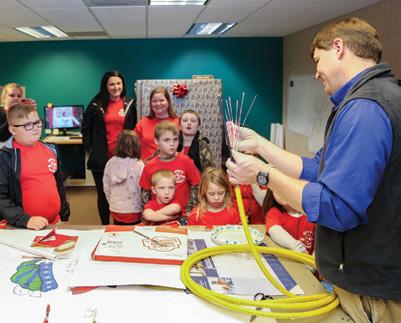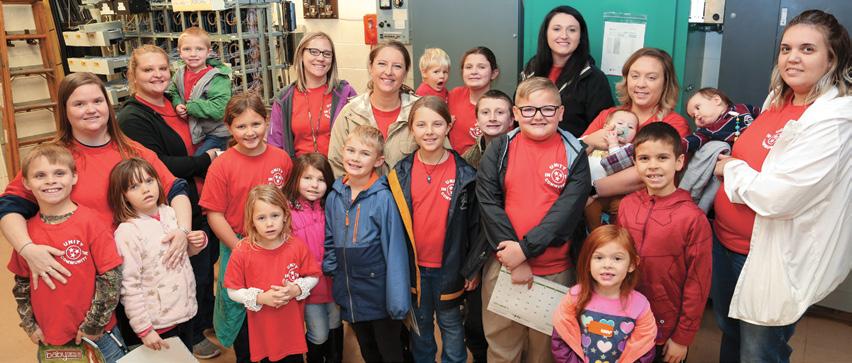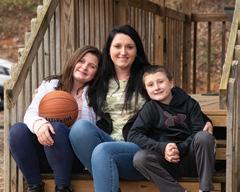
4 minute read
A comfortable Environment
Story by LISA SAVAGE | Photography by MARK GILLILAND
HOME SCHOOLING PROVIDES OPTIONS FOR FAMILIES
Jessica Angel and her children enjoy breakfast each morning before school.
Then, it’s off to get the day started at the kitchen table. Angel and the children, Kaylan, a fifth grader, and Eli, a second grader, read a book or work on writing skills. Then, Kaylan goes to her room and works independently for a little while Angel has more one-on-one time with Eli.
“We go at our own pace,” Angel says. “We take breaks when we need to and have some flexibility to do what works best for our family. It’s in a comfortable environment, and that enhances their learning.” This is the second year Angel and her husband, Eric Angel, have committed to home schooling for their children.
It takes commitment from everyone in the Pikeville family. Jessica Angel worked for several years at Omni Rehab and still worked full time when the family made the decision she would quit work so home schooling would be possible. “I prayed about it and really wanted to do it,” she says. “I felt like it was the best thing for our children, and I felt like I had a clear answer that it was the right thing to do.”
HOME-SCHOOL OPTIONS
Angel didn’t have to look far for guidance. Her sister, Laura Keedy, chose home schooling for her children and lives down the road.

BTC Fiber Engineering Manager Matt Boynton explains fiber optic technology to the home-school students who visited BTC Fiber’s office recently.
“I started asking questions and digging for information to find out what’s best for our family,” Angel says. They chose to utilize the umbrella school platform, which allows parents to work with a private school. That option requires English, math, science, language arts, history and other core subjects, but there is flexibility regarding the teaching process.
“We can incorporate a biblical curriculum,” Angel says. “Our language arts can be stories from the Bible, or our vocabulary words can be a combination of words that include biblical words.” An umbrella school option also means a student has a high school diploma after completion from an accredited program. Some home-school programs only provide a certificate of completion.

The home-school co-op group recently visited BTC Fiber’s office as part of a field trip day.
“It was important to me to make sure we’re working toward a high school diploma, not just a certificate of completion,” she says.
The umbrella school has requirements, such as 180 days of school, and guidelines about the curriculum, but it provides some flexibility. The Angels pay $100 a year for the first child and $25 a year for each additional child. “That’s a small price to pay for the assurance that we’re doing everything the way the law requires,” Angel says.
Her experiences in teaching the children showed Angel which techniques work best for each of them. For instance, she found that her daughter has a problem concentrating if others are around, so she learns more easily by herself. “I can see where each child struggles and where we need more one-on-one time,” Angel says. “They learn to work toward goals and getting better with the things they struggle with.” Going from working full time to home schooling has been a drastic change for the family.
“In the end, it’s been very rewarding,” she says. “I know they are safe and that I’m able to have a huge part in my children’s education.”
RESEARCH
When Angel sought her sister’s advice, Keedy told her to research and learn what was best for their family. Keedy says that’s the best advice for anyone considering home schooling. “Do your research before stepping off and taking that plunge,” she says. “It’s important to find out what fits your family and your child. Each child is different, and it’s a totally different approach.”
Both families also use internet service through BTC Fiber. That means more choices for home schooling.
She learned the umbrella plan also worked best for her family, and she learned through the home-school process that each child works differently. Keedy’s oldest daughter, Faith, was home-schooled her eighth and ninth grade years and attended public school during her sophomore and junior years.
Last year, she finished her senior year under a home-school program.
“She only needed two credits, so it didn’t make sense for her to stay in public school,” Keedy says. “She was able to do it at her own pace, and it was convenient that she could do it online.” Keedy’s other children — Hunter, a sophomore, Ashlyn, a fifth grader, and Sunday, a second grader — are part of a home-school program. Angel worked with her sister to come up with a plan for a co-op, which provides time one day a week for other home-schooled students to come together for class time, physical education, lunch and activities. The co-op also includes observation days for things like field trips to local businesses and other activities. An average of 23-26 kids participate in the co-op each week.

“It gives the children and parents a chance to interact,” Angel says. “One of the things we hear is that home-schooled children don’t have enough socialization, but this gives them lots of time to spend with other kids while we’re all benefitting from providing our children’s education at home.”
STATISTICS
• In 2019, home-schooled students made up 3.4% of school-age children in the United States.
• The most common reasons parents choose to home-school are concern about the environment in other schools, academics and religion.

